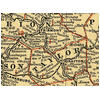



 Click for 1895 Area Map
Click for 1895 Area MapMany names were given to the great falls. Native Americans called it "Evil Spirit Falls," as they found it "difficult to possess." White explorers called it the "Hard Around Falls," an obvious reference to the rugged cataract over which the river plunges. Later it became "Falls of the Great Muddy," and finally was named for David Tygart, a pioneer settler.
The Tygart Valley River originates at a spring 4,000 feet above Valley Head, Pocahontas County, flowing one hundred miles before tumbling over a series of foaming falls at the head of a two-mile canyon near the Taylor-Marion County border. Sandstone ledges and two separate falls, one 15 and the other 18 feet in height, suddenly drop the river level some 70 feet.
In 1837, W. W. Fetterman purchased 1,000 acres which included the "great falls of the Tygart Valley River." Fetterman built a whip-saw mill and contracted and English stonecutter to cut a mill race for water power using black powder explosives for the first time in the area. Previously, the stone was heated by fire and cracked out. The finished mill provided most of the lumber for the surrounding area.
In 1847, coinciding with the building of the B&O railroad, construction began on a grist mill to utilize the raceway power. Three years later the new grist mill was completed and the first flour was ground. The mill produced 70 barrels of roller-pressed flour per day, that was retailed as "Pride of the Valley" brand.
1852 was a momentous year for Valley Falls. The railroad was complete, the first post office established. The streets were crowded with lumberjacks, traders, and railroad workers. Valley Falls grew into a sizable town with more than one hundred homes and businesses. Housing was in so short supply that two lumberjacks lived in a nearby cave. During its "boom" era, Valley Falls had sawmills, shoe shops, planning mills, a coffin factory, a spindle factory, a grist mill and a blacksmith shop. A hotel was constructed with a large hall where folks could have a good time with a fiddler, round dancers, Virginia Reel fans, tap dancers and clog steppers. A ferry was operated above the falls to carry people and supplies across the river. The ferry once got caught on a rock and went over the falls with a man on board who survived the "fun." When he surfaced, he had his hat on and his pipe still in his mouth.
During the Civil War, Valley Falls was a busy place with soldiers and supplies transported by the B&O railroad and a factory producing gunstocks was cut into blocks and stored in sawdust in an icehouse for summer use.
A disastrous fire destroyed most of the town in 1886 and it was only partially rebuilt. Valley Falls received its industrial deathblow two year later, the result of a great flood and poor planning. Approximately three million saw logs scheduled for railroad shipment were impounded behind a restraining boom above the falls. Heavy rains swelled the Tygart Valley River into a raging torrent, broke the boom, and swept a wall of logs 30 feet high through the town of Valley Falls, destroying everything in its path. A man on a hill saw what happened and said, "It sounded like four or five freight trains at the same time." The grist mill was repaired and operated until 1905. All the virgin timber was gone and the post office was closed.
In 1964 Valley Falls became a state park. Visitors to this scenic Marion County treasure marvel at the grandeur of the roaring Tygart Valley River flowing through the steep canyon over the rugged sandstone falls. Ruins of the historic mill and scattered stone foundations of the once thriving town can still be seen. Many recent additions including numerous hiking trails that lead guests of the park to scenic and interesting sites. A visit to historic Valley Falls State Park is a pleasure to be experienced.